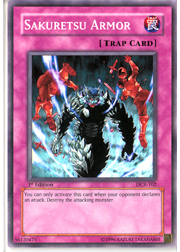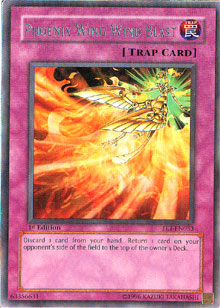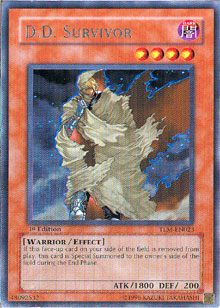Hi! Matt Murphy is on a brief hiatus today, though he’ll be back next week with another Apotheosis. That leaves me to fill his slot, giving me the perfect opportunity to write an article I’ve wanted to do for a couple of weeks . . .
With less than 72 hours between now and Day 1 of Shonen Jump San Mateo, one of the most important questions on duelists’ minds has to do with metagaming the number-one pick for the weekend: Light and Darkness Dragon. How do you beat it? How can you reliably oust one of the most powerful monsters of all time when it can negate your every move? With this question in mind, I’d like to take a last-minute look at some of the countermeasures we’re likely to see this weekend. If you’re looking for a way to beat the Dragon, hopefully I can give you some ideas. If you’re playing the Dragon yourself, this article will serve as a short checklist of things to watch out for. For those of you somewhere in between, you’ll get a good grasp of the cards you’ll be seeing more of this weekend, and the primary reason for their use.
The tricky part to teching Light and Darkness Dragon is that it’s a two-pronged task. You need to get around both its negation effect and its graveyard ability if you want to really dominate it, and that makes for two unique agendas. Let’s look at the negation issue first, and start with one of my favorite ways to deal with it . . .
Double Removal
Since Light and Darkness Dragon can only activate its negation effect once in each chain, you can chain another effect to the activation of its negation ability and get a shot at taking it down. Consider the following example:
Light and Darkness Dragon attacks directly. The defending player activates Widespread Ruin in response, and the Dragon’s effect activates to form a chain, threatening to negate the Widespread. The resulting chain looks like this:
Widespread Ruin Þ Light and Darkness Dragon’s negation
The chain resolves backwards: Light and Darkness Dragon negates Widespread Ruin. Then the Dragon’s attack continues and you get smacked. Less than ideal? I think so too.
But consider an expanded scenario:
Light and Darkness Dragon takes another direct swing. The defending player activates Widespread Ruin in response, and the Dragon’s effect activates next. Once the negation effect has been activated, the defending player chains another card that can destroy the Dragon—say, Sakuretsu Armor. In that case, this is the resulting chain:
Widespread Ruin Þ Light and Darkness Dragon’s negation Þ Sakuretsu Armor
 Sakuretsu Armor resolves and destroys the Dragon. Since the Dragon needs to remain on the field for its negation effect to resolve, the negation disappears. Widespread Ruin then resolves as normal, and if the opponent controls another attack-position monster, it’ll be destroyed too.
Sakuretsu Armor resolves and destroys the Dragon. Since the Dragon needs to remain on the field for its negation effect to resolve, the negation disappears. Widespread Ruin then resolves as normal, and if the opponent controls another attack-position monster, it’ll be destroyed too.
Widespread Ruin is of the utmost value here. Though its chief purpose is to provide Chain Link 1, its effect will still work as well, keeping you from losing a card just to get around Light and Darkness Dragon. Similar plays can be made with a single removal trap and something like Jar of Greed, Ceasefire, or The Transmigration Prophecy providing the first chain link. Even if you have to waste a card to get that first activation though, your opponent gave up two tributes and Light and Darkness Dragon to your two spell or trap cards—not a bad trade overall, especially considering the number of cards the Dragon could have cost you.
Expect to see this play driving Gadget decks to success over the next few months. They’re the one strategy that can easily accommodate all the removal traps this type of move requires. In addition, expect to see some Zombie decks and other strategies teched to dish out this kind of move.
Negating the Summon
One way to keep Light and Darkness Dragon’s negation effect from nerfing your cards is to keep the thing off the field entirely. If that’s the approach you’d like to take, consider Forced Back over Solemn Judgment. Judgment has higher utility and will banish the Dragon to the graveyard, but it’ll also put you within striking distance of a second Dragon, and frequent complements to Light and Darkness such as Elemental Hero Stratos will become major threats.
Forced Back may not destroy the Dragon itself, but that has its advantages. Destroying Light and Darkness, even before it’s hit the field, will get your opponent a free special summon thanks to the Dragon’s third effect. The fact that you’re neglecting to get the card into the graveyard isn’t that big of a deal, since you’re costing the opponent two tributes to your one trap card. He or she will need another turn or two to recover from that, and if you can capitalize on the opening you’ve created, you’ll be in a great position to keep the opponent off the field.
Phoenix Wing Wind Blast
Spinning Light and Darkness Dragon back to the top of the opponent’s deck after he or she paid its tribute cost is certainly ideal, but it’s not easy. Legendary Jujitsu Master and Raiza the Storm Monarch will both have their effects negated since it’s basically impossible for either to function beyond Chain Link 1. Back to Square One is a normal spell and thus not an option.
 Phoenix Wing Wind Blast, however, fits very nicely with the double removal technique described earlier in this article. It can function as a very good Chain Link 1 to be followed by a Chain Link 3 removal effect, or it can be chained in response to the activation of Light and Darkness Dragon’s ability in order to get it off the field and ensure that your first effect on the chain resolves properly.
Phoenix Wing Wind Blast, however, fits very nicely with the double removal technique described earlier in this article. It can function as a very good Chain Link 1 to be followed by a Chain Link 3 removal effect, or it can be chained in response to the activation of Light and Darkness Dragon’s ability in order to get it off the field and ensure that your first effect on the chain resolves properly.
Wind Blast will also help you interfere with the tribute fodder that so often fuels the Dragon’s summoning. When the opponent brings out Destiny Hero - Malicious from his or her deck, you can respond with Wind Blast to send Malicious back to the top of the opponent’s deck. That deprives the opponent of his or her tribute and forces him or her to draw what’ll probably be a dead card next turn. You can also chain Phoenix Wing Wind Blast to the ubiquitous “Call of the Haunted or Premature Burial for Disk Commander” move, which usually marks the beginning of crazy things involving multiple copies of Dragon hitting the field in succession. Against more fringe variants, you can spin away Green Baboon, Nimble Momonga, or Apprentice engine monsters too.
Skill Drain
One of the most direct ways to shut down the Dragon’s negation effect is just to flip Skill Drain. If you can flip it in a chain after the Dragon’s effect has been activated—or just flip it before the Dragon hits the field—then it won’t be able to negate anything you try to do.
While this gives burn decks quite the edge, it also may give duelists a reason to dust off old strategies like Dark World Skill Drain. Alternately, this metagame trend may also finally give Green Baboon Skill Drain builds the opportunity they had so often in Japan, but have completely lacked here in North America. If your deck happens to be relatively unaffected by Skill Drain, consider siding or even maining multiple copies.
Repeated Free Effects
One of the easiest ways to overcome Light and Darkness Dragon is to bombard it with effects. I guarantee you’ll be stuck doing so sometime in the near future if you play in tournaments regularly: hucking card after card at a Dragon just to bring it down to a manageable size. And spending cards to do that really stinks. However, if the effects you hurl at the Dragon’s effect-blocking hide are all free thanks to continuous traps or repeatable monster abilities, you’ll be in a great position. Every free ATK reduction that you can muster makes the Dragon easier to destroy, and four effects will leave the Dragon without the necessary DEF to continue negating cards.
Spirit monsters or Treeborn Frog can blast clean through all four of the Dragon’s negations, but while Treeborn is easy to side into many decks, the Spirit monsters seem sub-par in the average metagame nowadays. The most common recruiters—Pyramid Turtle and Giant Rat—lead into monsters that Asura Priest can’t take out. Susa Soldier isn’t big enough and never has been, Inaba White Rabbit is fun but would need some serious support, and Maharaghi, arguably one of the strongest options, is deathly slow in faster matchups. Otohime may have a chance, providing faster decks with gateways to the opponent’s life points, but there are better ways to generate repeated effects for free.
Namely, the Six Samurai. While the Samurais’ consistency continues to be a hotly-debated issue, you can’t really argue with the ton of free effects they bring to the table. The Six Samurai - Yaichi, The Six Samurai - Kamon, and especially Enishi, Shien’s Chancellor are all adept at giving you something for nothing, and that makes them an important set of options facing down Light and Darkness Dragon. Watch for them to crop up this weekend in the Samurai/LADD matchup.
Remove-from-Play Effects
 Moving on to Light and Darkness Dragon’s third effect, the use of remove-from-play conditions obviously trumps the Dragon’s special summoning. If it can’t go to the graveyard when it’s destroyed, it can’t get that effect. Decks like Macro Cosmos/Dimensional Fissure could do very well, while duelists siding into three copies of Dimensional Fissure and three D.D. Survivor cards may find that their metagame call was a good one. Beyond that, Banisher of the Radiance can turn any piece of chained removal into an instant answer to all your Dragon troubles: another easy choice for Gadgets. Even Karma Cut could make a decent choice, since it’s easily chained to the Dragon’s negation.
Moving on to Light and Darkness Dragon’s third effect, the use of remove-from-play conditions obviously trumps the Dragon’s special summoning. If it can’t go to the graveyard when it’s destroyed, it can’t get that effect. Decks like Macro Cosmos/Dimensional Fissure could do very well, while duelists siding into three copies of Dimensional Fissure and three D.D. Survivor cards may find that their metagame call was a good one. Beyond that, Banisher of the Radiance can turn any piece of chained removal into an instant answer to all your Dragon troubles: another easy choice for Gadgets. Even Karma Cut could make a decent choice, since it’s easily chained to the Dragon’s negation.
Kycoo the Ghost Destroyer is a potent option as well, protecting your own graveyard from D.D. Crow while removing important monsters your opponent would want to special summon later with Light and Darkness Dragon.
Messing with the Graveyard
Speaking of D.D. Crow, messing with the Light and Darkness Dragon player’s graveyard is another strong strategy for debilitating his or her tribute base and keeping Light and Darkness from its best special summon targets. The Crow provides a simple move that works well in other matchups, but The Transmigration Prophecy really doesn’t get the attention it deserves. Using it as your Chain Link 1 to draw out the Dragon’s negation effect, followed up with something that gets the Dragon off the field, carries a one-two punch that shouldn’t be ignored. You can get rid of the Dragon while also assuring two things. First, that re-summoning it (or summoning another) will be more difficult, since cards like Malicious and Treeborn can get kicked out of the picture. Second, that when the Dragon does come out, it won’t have any desirable special summon targets like Disk Commander or Dark Magician of Chaos.
So there you have it. Is it a complete list of ways to get the best of Light and Darkness Dragon? Far from it. But these are all relatively easy measures you can take as you prepare for the Dragon-dominated environment we’re likely to see, and every trick you know could be one more win added to your record.
One of the most important Shonen Jumps of all time is just two days away. See you on Saturday.
—Jason Grabher-Meyer